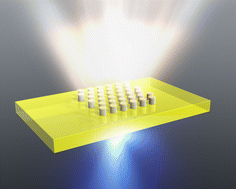Photoluminescence engineering with nanoantenna phosphors†
Abstract
In nanophotonics, light-scattering nano-elements are referred to as nanoantennas due to their ability to harness light. Nanoantenna phosphors, i.e., phosphor plates combined with nanoantenna, enable spatial and spectral control over luminescence. While the emission enhancement in a specific direction has been reported in nanoantenna studies, the evaluation of the total distribution of radiation as well as the conversion efficiency is largely missing. In this study, we visualize the distribution of photoluminescence from the nanoantenna phosphor into forward, backward, and side directions by using an integrating sphere. Our nanoantenna phosphors consist of a hexagonal array of titanium dioxide (TiO2) nanoparticles, fabricated on a phosphor plate of yttrium aluminum garnet doped with Ce3+ (YAG:Ce). The experimental results clarify that the nanoantenna increases the forward emission and decreases the side emission, while the total emission intensity remains unchanged. We further enhance the forward emission by depositing the Bragg reflector on the bottom of the plate. A simple analytical model can explain the effects of the antenna size, the plate thickness and the Bragg reflector on the distribution of radiation. The present study allows the flow of photons inside the nanoantenna phosphors to be understood and is useful for the efficient use of photoluminescence.



 Please wait while we load your content...
Please wait while we load your content...